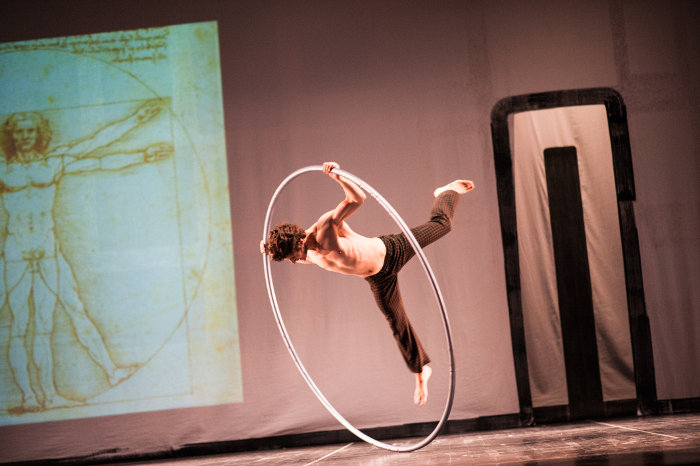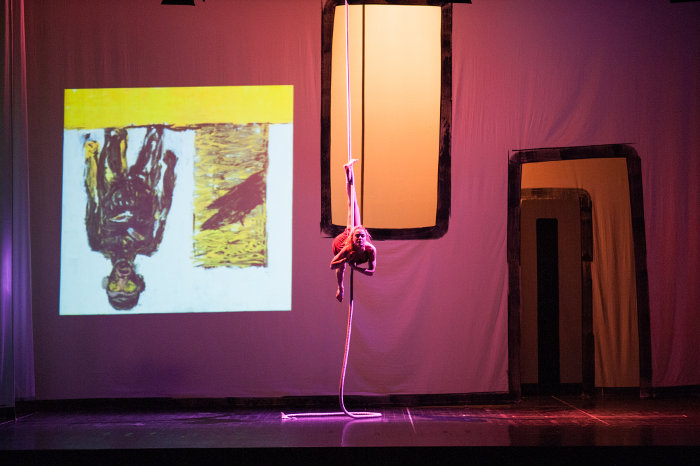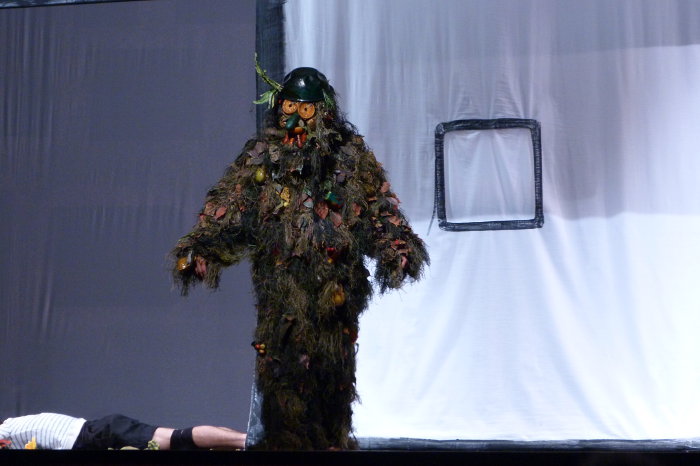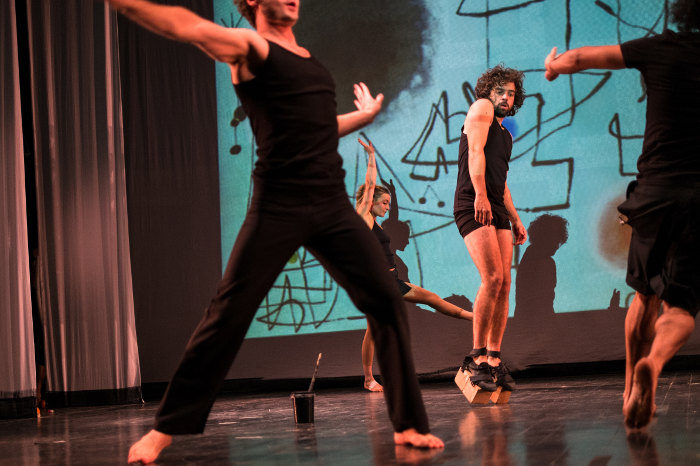Every winter in December, Barcelona’s Ateneu Popular de Nou Barris presents a new in-house circus production. This year it’s Aaart!, a show that connects the language of circus with the world of painting. Director and scenographer Xavier Erra talks first about the piece's opening act, performed by the Sardinian acrobat Jonathan Frau and inspired by the work of the Austrian painter Egon Schiele, then is joined by members of the cast to reflect on the creative process.
Something amazing happened with this act Jonathan Frau performed on the work of Egon Schiele, but I want to tell you something first. I was doing the research for the show when I discovered the paintings of that Austrian artist and thought: ‘These pictures look like Jonathan’s work; it seems pretty much the same to me, expressed in different languages — paint and floor acrobatics. It’s the same understanding of the human body.’ It was very clear to me that Jonathan’s movements were a performance of Schiele’s pictures, so I proposed him this painter to work on.
Before that, I had included Jonathan in The Art of Flying, a show I directed at the Ateneu Popular de Nou Barris in April 2013, for his peculiar way of doing acrobatics. That show was one of the origins of Aaart!; the other was a piece called The Landscapes Collector, produced in 2008. It had very few circus techniques, but was another production in which I mixed different languages — in that case, painting, music and physical theatre. I connected landscape painters from Bruegel to Emil Nolde with contemporary music pieces by Béla Bartok and Igor Stravinsky.
The Art of Flying was a piece that had to fit into the Ateneu’s regular circus programming, but it was also one of the venue's Combinats — a show combining the existing acts of different artists under the supervision of a director and using professional equipment. That’s not to say that this kind of show is performed by beginners — not at all. The Combinats de Circ are a regular stage in Barcelona, an opportunity for artists to show their acts and for audiences to regularly see some circus routines. But in fact, I’m not a circus director, so I chose every act for its beauty and didn’t want to change it. Those acts didn’t have any relation between them or anything to do with some subject or drama. As the director, I wanted to find the way to make them shine and let every artist perform freely. Once the casting was complete, the subject of cinema came to my mind and I used this to set the structure of the show. I wanted this structure to be very clear to reassure the group: a brief break would be placed between each act and filled with excerpts of films. I didn’t pretend to incite an intellectual perception, but rather wanted to avoid tiring people as happens sometimes with some theatre plays using a sustained rhythm or even some circus shows. I wanted to avoid also a too explicit relation between the films and the acts — no movies about circus, out! I preferred the idea of intuitive linking and used suggestive scenes from films by Andrei Tarkovsky, Jean Epstein, Alfred Hitchcock, Lotte Reiniger and Jean Painlevé. The scenery on the stage was very simple: a screen apparently made of sewed cloths on which films could be projected to highlight every act. The music was also decided two months before the premiere. In that new context the artists definitely contributed to the creation of the show by adapting their acts to it.
The Art of Flying was a local success that was supposed to be adjusted and rehearsed again after the summer for Barcelona’s La Mercè festival. In the end it was not possible, but then came the chance to direct the production of the Circ d’Hivern this year. I’m very glad of it because it’s the 18th edition, which means this event is reaching its age of majority, and because I’ve had the opportunity to work with great professionals: besides the artists, there’s also Rosa Solé the costume designer, Joaquín Guirado working on the lighting design, and Guillermo Aranzana, from the company Balagans, who helped us a lot with the choreography of the last act of the show, inspired by a Joan Miró picture.
For Aaart! the artists were meant to be the same as those that created The Art of Flying, though in the end only Jonathan Frau and another artist, Guillermo Aranzana, returned. I followed the same creation process, providing a context in which the artists could expand themselves, though this time I was working with an idea that had already been developed and tested. The dramatic scenario is very simple: a group of circus artists are lost in a museum. Then there were some painters I clearly wanted to bring to stage and some others on whom I hesitated a bit. Again, I wanted to avoid pictures on explicit circus subjects and didn’t want to create an intellectual show. Obviously, the person in the audience who knows Kazimir Malevich or Joan Miró will enjoy the show in a different way, probably will see things that others won’t, but these others will perceive anyway this connection of languages throughout all the acts. I think there’s the vibration of arts throughout the show — that’s my aim at least! From the very beginning I aimed at the fun part of visual arts, their life, didn’t want to show them as something dead and in the past as we too often learn at school. No! visual arts are emotion and also can be a game — a physical game.
Well, after the research I designed the set. Once again I wanted big panels to project the pictures on. This time, instead of one single screen, the stage would have several curtains with framed doorways forming a corridor to the back, imitating a museum. For Jonathan’s act we could distribute the action in two lines — one side-to-side at the front of the stage, and a second in depth that allows him to move back and forth. After him, the first panel is raised and the stage is automatically reset for the next act, the balance on wooden blocks performed by Nacho Flores. As the show goes on, the space gets deeper. Every act has its own configuration, as if it would happen in a different room of the museum.
So I created the context and the artists did the rest. Aaart! is in fact a collective creation. Once the group that performed The Art of Flying split I chose new artists for what I knew they did or for their ability to perform a given discipline I wanted in the work — artists like Sergio González...
The Aaartists




Sergio González: Xavier didn’t know my work and I wasn’t very experienced with Cyr wheel, but he really wanted someone to perform this discipline because he had in mind Leonardo da Vinci’s drawing of the Vitruvian Man. Other artists he approached couldn’t do the dates and eventually he found me. I was training Cyr wheel at La Central del Circ, in Barcelona. In my case, we met each other by chance. But I have to say that even if the resemblance between the drawing by Da Vinci and a Cyr wheel act is obvious, for me it wasn’t easy to give it motion. That image is still, whereas I had to play the living character of someone who is lost in a museum; besides, the movements of this character and those of the acrobat had to be coherent with each other.
Irene Estradé: My case is quite similar because, though I’ve been performing different circus techniques for years, mainly hand-to-hand and some aerial, the vertical rope is quite new for me — I started with it just two years ago. Xavi came to see my work and guided me to match my act with a painting by Georg Baselitz showing an upside-down person.
Xavier Erra: Yes, because this painter has a strong power for circus even if he is not at all a circus painter. His portraits of people turned upside-down are a provocation, just as an acrobat is. They both challenge common sense.
Irene Estradé: I adapted my act for Aaart! considering the intention of the painter more than the image. I tried to figure out what sensations or emotions Baselitz wanted the viewer to feel and worked at this same level.
Xavier Erra: For Nacho, Carlos and Jonathan, it was a little different. Carlos Lima worked with Jonathan in a hand-to-hand act that I included in the show, and he also replaced the clown from The Art of Flying in a new scene inspired by the Italian painter Giuseppe Arcimboldo — the 16th Century artist who made portraits using vegetables. Nacho Flores had a very appealing balancing act on wooden blocks, very appropriate for a Circ d’Hivern production, so I decided I wanted him for the show and started to research what painter could match him. Eventually I found Kazimir Malevich was the one.
Nacho Flores: Yes, my work with the blocks is also sculpture somehow and it can go along very well with the aesthetics of cubism or Russian deconstructivism. Anyway I hadn’t thought much about all these references until Xavier proposed that I be in the show with Malevich. He showed me some of his paintings and sketches as well as some biographical writing, and I found it wouldn’t be very difficult to bring him onto the stage. It’s a bit like doing a version in 3D. The movement hasn’t been a big problem for me as it has been for Sergio because my act is quite static, so the main thing was to collect the essence of that painter.
Xavier Erra: With Jonathan I did the same matching process, but then something wonderful happened. He already knew Egon Schiele when I called him to say I had discovered a painter that very much reminded me of his acrobatics. But not only this: Jonathan is an admirer of Schiele and inspired by him. I mean, it was so before I even thought about this show! He had traveled to Vienna to see the paintings and knew him deeply.
Jonathan Frau: Yes, my work strongly evokes Egon Schiele. Not only the acrobatics — my drawings and paintings as well. I studied sculpture and painting in Bologna and there I came to know this painter. I really liked him, so when I started my physical work I took many of his expressions, tensions and twists. I share a good part of his imagery. It was a big coincidence that Xavier proposed me Egon Schiele — it made me very happy! This is connection!
Xavier Erra: When we set up his act for Aaart! I also wanted him to play with shadows. It’s the only such act in the show and it comes from The Art of Flying too. In that case, shadows were the finale, when all the artists returned to the stage to dance for the farewell. It was a funny reference to the origins of cinema — both shadows and circus have much in common with it. Now, in Aaart!, the shadows refer to the pictures, in particular those we see scrolling at the very beginning of the act. We go from the 2D of the paintings to the 3D of the physical work and then back to the 2D again. I wanted to mark this relation at the beginning of the show, but didn’t want to make it very obvious, because there’s the risk of becoming didactic. I can’t stand being didactic, and the shadows are a good way to switch 3D into 2D and maintain different levels of perception which, as I was saying before, are more intellectual or intuitive.
But back to the connections between the visual artists and the acrobats, as I had another surprise coming...
Carlos Lima: Jonathan and I have been working on our hand-to-hand act for the last four years, though we’ve adapted it quite a bit to the situation required in the show. Not so much the balancing work itself, but the sequence of the whole act. It hasn’t been that difficult since we know each other very well. Anyway, Xavier showed us one of the Caprichos by Francisco de Goya, ‘Rising and falling’, in which a kind of monster is holding a man up by his feet and he stands over the monster’s head. That was the exact position of the ending of our act.
Xavier Erra: They screamed when they saw that drawing. Isn’t it amazing? I had chosen painters and artists for their work and tried to match them, and they were already connected! It’s like catching these circus artists doing the same things Goya, Miró, Baselitz, Malevich or Schiele had done years ago! Or the other way around — catching the painters acting like acrobats.
Xavier Erra was born in Barcelona in 1967. He graduated in Fine Arts in 1992 and then studied Scenography at the Institut del Teatre in Barcelona. Among the circus shows he has worked on, Plecs, by the company Enfila’t, must be highlighted.
Jonathan Frau was born in 1985 on the island of Sardinia, Italy. He practiced gymnastics before deciding to avoid competition and turn his physical work into something creative, away from the gymnastic codes. He's also a member of the company Oktobre, who were selected as CircusNext laureates in 2012-13.
The extracted performance of Jonathan Frau’s act in Aaart! is taken from a presentation on 12 December 2013 for primary schools before the official premiere in Ateneu Popular de Nou Barris, Barcelona.
Xavier Erra was interviewed by Cesc Martinez on his previous show The Art of Flying on 26 April 2013 in his studio in Barcelona. Three more interviews were done while Aaart! was being created: 16 September 2013 in his studio, 5 December 2013 after a rehearsal with all the artists at Ateneu Popular de Nou Barris, Barcelona, and 6 December 2013 via telephone. Cesc Martinez is a Catalan linguist, writer and theatre reviewer. He was content coordinator of the Spanish circus magazine Zirkolika, and since 2012 has been the editor of the triple website Puppetring.com / Titeresante.es / Putxinelli.cat focused on puppetry and visual theatre.
This interview was produced as part of the project Deconstructing Circus with the support of Arts Council England.